Badnaviruses (family Caulimoviridae, genus Badnavirus) have emerged as serious pathogens especially affecting the cultivation of tropical crops. Badnavirus sequences can be integrated in host genomes, complicating the detection of episomal infections and the assessment of viral genetic diversity in samples containing a complex mixture of sequences. Yam (Dioscorea spp.) plants are hosts to a diverse range of badnavirus species, and recent findings have suggested that mixed infections occur frequently in West African yam germplasm. Historically, the determination of the diversity of badnaviruses present in yam breeding lines has been achieved by cloning and sequencing of polymerase chain reaction (PCR) products. In this study, the molecular diversity of partial reverse transcriptase (RT)-ribonuclease H (RNaseH) sequences from yam badnaviruses was analysed using PCR-dependent denaturing gradient gel electrophoresis (PCR-DGGE). This resulted in the identification of complex ‘fingerprints’ composed of multiple sequences of Dioscorea bacilliform viruses (DBVs). Many of these sequences show high nucleotide identities to endogenous DBV (eDBV) sequences deposited in GenBank, and fall into six monophyletic species groups. Our findings highlight PCR-DGGE as a powerful tool in badnavirus diversity studies enabling a rapid indication of sequence diversity as well as potential candidate integrated sequences revealed by their conserved nature across germplasm.
Region: Africa
Date published:
2017
Published by:
Viruses
Type of resource:
Journal article
Resource topic:
Yam
Project/Programme: Not specific
Pest/Disease: Badnavirus
Pages:
24
File type:
External link (3.8 MB)




